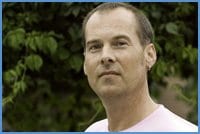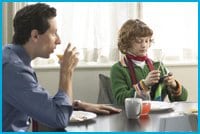
ON THIN ICE. Breakfast with Scot director Laurie Lynd boned up with Hockey for Dummies before filming the rink shots. "I have a lot more respect for the game now." Credit: Paula Wilson
Ever notice how a good proportion of today’s kids movies are still encoded with the same rigid gender stereotypes of yore? Well, be prepared to feast upon Breakfast with Scot, a surprisingly insightful family movie at the Toronto International Film Festival (TIFF) this year that takes an unashamed look at the inner namby-pamby in us all.
Director Laurie Lynd (House, Virtual Mom) breaks interesting new ground with his first theatrical feature film in more than 10 years. Breakfast with Scot tells the story of Eric (Tom Cavanagh of Ed fame) and Sam (Ben Shenkman; Law and Order, Angels in America), two “straight” gay men who must unexpectedly take care of 11-year-old Scot (Noah Bernett), a sissy of gargantuan proportions.
Solid directing, writing and acting make the movie a fresh and curious family tale. “It was very important for me to have gay characters in a family movie,” says Lynd. “As soon as I read the treatment I was like, oh my god, I really want to make this movie.”
But the filmmaker shared a more personal bond with the eponymous character. “I totally related to Scot because I was an 11-year-old sissy. And part of me still is,” he laughs.
Sissiness aside, Lynd is an accomplished director, having worked with the likes of Brenda Fricker, Ned Beatty, Don McKellar and Debbie Reynolds. His popular BBC miniseries I Was a Rat averaged seven-million viewers a week in the UK, received rave reviews and was the opener for the Sprockets Film Festival.
While Breakfast with Scot showcases Lynd’s talent for entertaining young audiences, it comfortably bridges over to adults as well. The story is just as much about Eric, a former hockey pro whose insistence on keeping things on the down-low causes friction with his longterm partner. But when Scot arrives in all his taffeta-and-chiffon glory, Eric’s hidden world is put to the test.
The film was catapulted into fame – and some controversy – when it garnered the full-on endorsement of the NHL and the Maple Leafs. So Eric is an ex-goon from the Maple Leafs while Sam is the team’s lawyer. “I was floored,” says Lynd, “I thought never in a million years would they say yes. It would be a big deal to get their permission to use their logos in any movie.” Even larger budget Canuck films like Bon Cop, Bad Cop didn’t get that kind of nod.
Stories about this little gay flick’s hockey coup started appearing in media all over the world, mirroring the director’s surprise and elation. “There’s just something about the fact that you see Tom Cavanagh’s character in a Maple Leafs jersey – I’m thrilled about that.”
But not everyone was thrilled. Especially rightwing fanatics such as James Hartline (an ex-gay I might add) who immediately denounced the NHL and its alignment with the “radical homo sexual movement.” The backlash came halfway during their film shoot and really threw Lynd for a loop. “I found it so upsetting I couldn’t finish reading it at the time – to read something so hateful about something that’s so sweet.” But the NHL, which, as of yet, boasts no openly gay player, stuck to its guns and upheld its support of the film.
Nevertheless, Breakfast with Scot lives up to all the endorsements and spilled ink. Chalk much of this up to the succinct screenplay by Sean Reycraft (Slings and Arrows), based on the novel by Michael Downing. There’s a naturalness to the dialogue and to the characters that is seamless and enjoyable.
In addition the actors are commendable, never portraying the characters as clichéd or unrealistic. This rings particularly true of newcomer Bernett. “We auditioned tons and tons of kids,” says Lynd. “A lot of them were good young actors but they would put on affectations, like mincing as if they were gay.
“All it is is enthusiasm, and Noah was the only one who really got that.”
Lynd takes pride in keeping things in the film understated. “I wanted people to like Scot. We have fun with him but I don’t think we ever make fun of him.”
There was one scene where Lynd pushed to make sure the couple is seen as a couple. “I was like, ‘no, no, we’ve got to see them in bed together’…. I didn’t want them to seem like roommates. It’s a very light scene. You’re seeing two men in bed together, talking to an 11-year-old boy and it’s not a big deal.”
The film works because it’s not only a story about an older gay man still coming to terms with his gayness, but it’s also more generally about parents whose kids force them to face their own demons.
“I think we all have our internalized homophobia to varying degrees,” says Lynd. “To me it’s more sophisticated and interesting that it’s gay guys who are threatened by this sissy kid.
“I think so much about how gay men are represented it doesn’t address the self-doubt that we all have…. I’m sure there are a lot of couples out there where one’s more out than the other, and it grates. I mean, I’ve been in relationships where it’s like that, where I would be frustrated.”
A lot of gay male culture today also reinforces a traditional masculinity. “I feel very out of step with a lot of current gay culture. You know it seems so macho in so many ways. Again, I feel as a community, I think there’s a bit of internalized homophobia and not letting in the sissy enough. So I think this movie is about celebrating the sissy.”
Lynd himself is familiar with such celebration. A lover of movie musicals, he was making papier maché figurines of Barbra Streisand in grade five. “I haaated gym class,” he remembers. “You’d have to play baseball and I would be in the outfield just praying that the ball wouldn’t come toward me.”
Not surprisingly, Lynd was most trepidatious about shooting the hockey scenes. “That’s a real challenge. I wanted to film it so that the people who like hockey are going to respect how it’s done.”
Boning up with Hockey for Dummies and talking with friends who play the sport resulted in some fast-paced action sequences, with hits and all. “Actually I have a lot more respect for the game now. I didn’t realize how complicated it is.”
It’s interesting to imagine what kind of moviegoers Breakfast with Scot will attract. While the film foregrounds a gay couple, it is still quintessentially “family” (not in an ex-gay kind of way, mind you). “I’d be thrilled if it played in multiplexes in the suburbs,” says Lynd, smiling. “I’m really hoping this will play very well to a gay audience and a very mainstream audience.”
With Breakfast with Scot poised for success at the festival, Lynd can’t afford to coast and is already busy shopping around his next film, Was, based on the popular novel by Geoff Ryman. Film making is a contact sport, after all, and not for the feint of heart, sissy or no sissy.

 Why you can trust Xtra
Why you can trust Xtra


